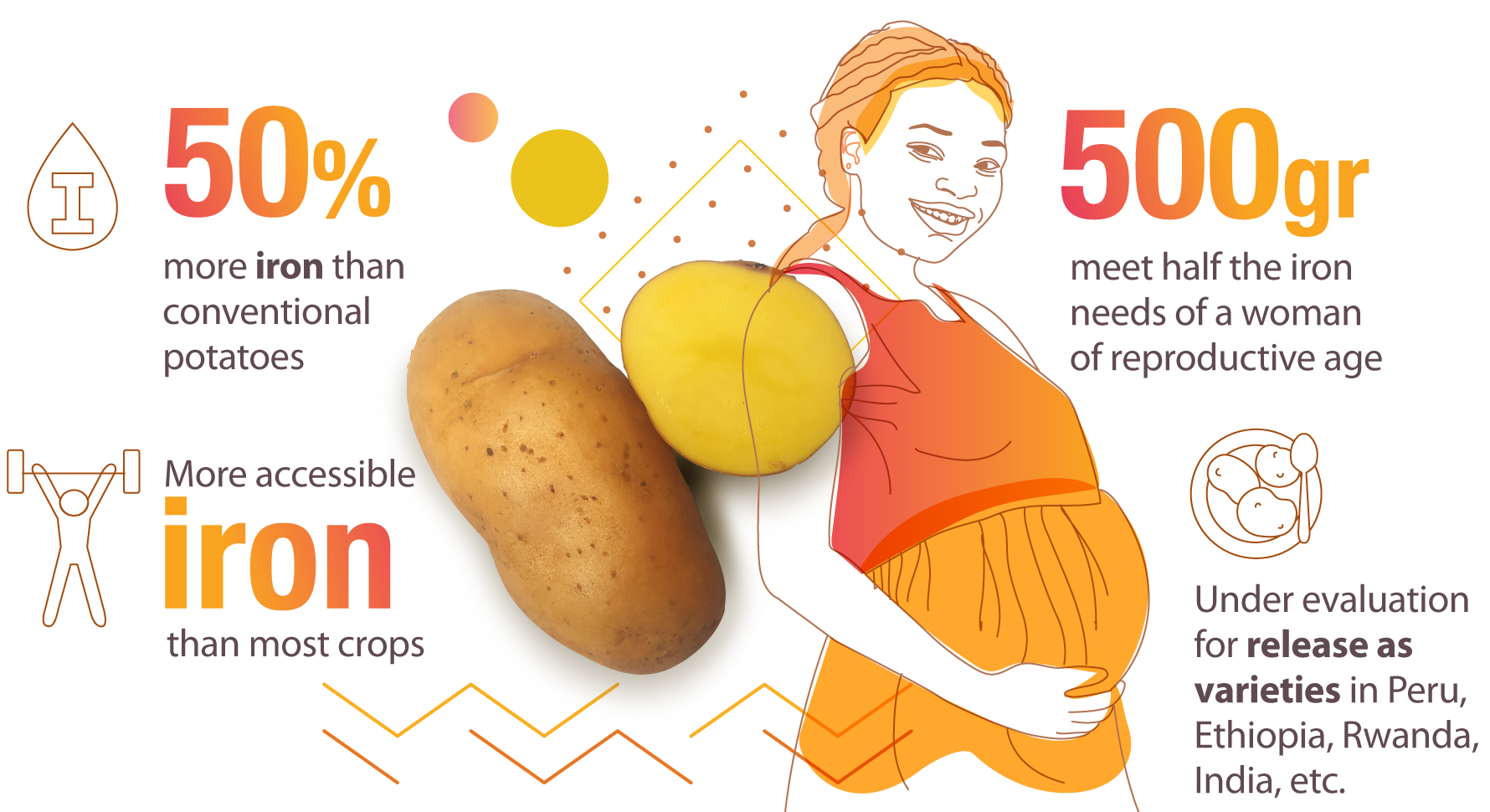Powerful potatoes
Biofortification boosts potential to combat anemia
The daily diets of more than two billion people globally lack enough essential vitamins and minerals. This reality leads to ill health and lost productivity that cost the global economy an estimated USD 3.5 trillion annually. Iron deficiency is one of the most pernicious forms of undernutrition and the leading cause of anemia, which can impair children’s physical and cognitive development and increase the risk of maternal and child mortality.
Over the last two decades, CGIAR has invested in biofortification—the process of breeding that increases vitamin and nutrient content in food crops. It is considered a sustainable and cost-effective way to boost both nutrition security and farmer livelihoods, especially in areas where most families lack access to diverse diets, supplements or fortified foods. Peer-reviewed clinical trials have demonstrated that biofortified crops can improve nutritional status and health, and recent research in the Peruvian Andes published in the Journal of Nutrition in 2020 indicate that iron-biofortified potatoes could be especially effective at preventing anemia.
In what was the first human study of iron absorption in potato, iron-deficient women of reproductive age in Peru’s Huancavelica region ate 500 grams of potato a day for two weeks. Whereas people absorb 2-10% of the iron available in most vegetables, pulses and other crops, researchers found – via red blood cell analysis – that these women absorbed as much as 29% of the iron in the potatoes they consumed.
Accessible iron
Gabriela Burgos, a nutritionist at the International Potato Center (CIP), and one of the study’s authors, explains the importance of these findings: “We now know that potato, even though it has much less iron than beans or spinach, has great potential for reducing iron-deficiency because a higher proportion of the potato’s iron is absorbed by the human body.” Through biofortification, CIP breeders have enhanced potatoes’ iron content with up to 50% more iron than conventional varieties. Those potatoes are the products of a 17-year process that began with identifying and crossing of high-iron Andean cultivars, which were later crossed with advanced breeding parents to produced high-yielding, disease-resistant, iron-biofortified potatoes.

Participants in the Peru study ate test meals of one of those biofortified potatoes with purple-flesh, or a native variety with yellow flesh. Researchers discovered that iron from the purple-fleshed potato was absorbed at half the rate of the yellow one, and surmised that compounds responsible for the potato’s purple hue may inhibit iron absorption. CIP will consequently concentrate on promoting yellow and cream-colored biofortified potatoes, 500 grams of which could provide half of a woman’s daily iron needs.
Disseminating nutrition
To get those potatoes into the farms and diets of families in rural Peru, CIP and partners have undertaken field evaluations of biofortified cultivars at 11 sites across the country to identify the best candidates for release as national varieties. A combination of participatory selection with nearly 300 farmers (40% of them women), lab analyses and taste testing resulted in a short list of eight potential varieties, one or two of which will be released and promoted in Peru in 2023.
In 2020, CIP collaborated with government and NGO partners to promote the cultivation and consumption of several potential varieties in two impoverished districts of the high Andes where anemia is common. Using a gender-responsive approach that combined nutrition education, seed potato distribution, farmer training, and a radio ads about iron-biofortified potatoes, this campaign helped farming families evaluate, select, and grow three biofortified variety candidates.
Hugo Campos, CIP’s Director for Research, explains that while reducing the high risk of anemia in those communities, this intervention also validated a strategy for taking biofortified potatoes to scale that could be used in other parts of Peru and in other countries, such as Ethiopia, India and Rwanda, where the biofortified potatoes are currently under evaluation.
“With an effective diffusion strategy, iron-rich potatoes will make an important contribution to reducing the currently unacceptable levels of anemia globally,” Campos says. “In the long run, this could improve the health of smallholder families, enhance productivity and incomes, and decrease illness and associated expenses.

Funders: CGIAR Trust Fund donors; European Union; HarvestPlus; International Development Research Center; Secretaria Técnica de Coordinación del CGIAR; United States Agency for International Development.
Partners: Agencia Agraria de Julcán; Asociación Pataz; Asociación Yanapai; Biotechnology and Biological Sciences Research Council; CARE; ETH Zürich; Instituto de Investigación Nutricional, Perú; Instituto Nacional de Inovación Agraria, Perú; Ministerio de Desarrollo Agrario y Riego, Perú; Ministerio de Desarrollo e Inclusión, Perú; Municipalities of Curgos and Julcán, Perú.
Associated CGIAR Research Programs or Platforms: Agriculture for Nutrition and Health; Roots, Tubers and Bananas.


